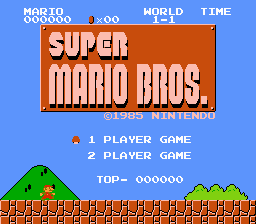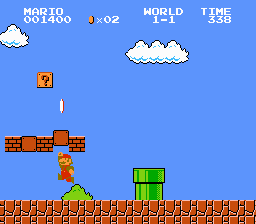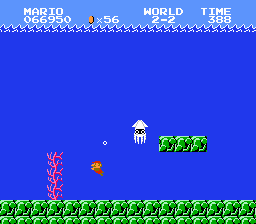Forum Links
Thread Information
Thread Actions
Order
Cool
Game's Ratings
Overall
Graphics
Sound
Addictiveness
Depth
Story
Difficulty
Average User Score
9.3
8
8.7
9
7.5
6.1
6.7
06-26-13 10:23 PM
Dmanfun is Offline
| ID: 826510 | 2115 Words
| ID: 826510 | 2115 Words
According to those boring writing classes I had to take way back when, all essays should start with some introduction, some hook to get the reader interested. And yet, what can I say? You've heard it all already: 14 or so variations of the game that started Nintendo's dominance, a dozen or so appeals to nostalgia, 8 different methods of calling the game groundbreaking or revolutionary, 6 or so history lessons about the video game crash, and even one or two jokers comparing Mario to a certain drug experience. So I think I'll just skip this whole introduction thing and get right down to my thesis statement: Super Mario Brothers is the perfect example of what the elementary platformer needs in order to be fun. What do I mean by that? Well, let's start with the obvious: a platformer requires jumping. And so Mario can jump (duh). And his jumping can be controlled quite easily as well. A running jump or prolonged press of the button obviously means flying faster, farther, and higher. And the plumber is even allowed to defy physics with some amount of horizontal mobility while in the air. Only some though - no amount of button trickery can get you back onto a platform you took a flying leap from. But you can gauge were you are going to fall and adjust accordingly, a skill that will become second nature to you as the game wears on. Perhaps the Belmonts of Castlevania fame ought to study this little plumber. Ricocheting off walls, jumping on platforms directly above you, and jumping off again as soon as you hit the ground are all skills you will need in abundance as well, and all can be achieved without too much effort. But it is more than these fine-tuned controls that matter; the level design plays just as much of a role in pleasurable jumping. This is no haphazard hodge-podge of pits and blocks; this is a near perfect design. For instance, there isn't just a pipe there to force you to jump for fun. Look beyond it. If you take a weak jump, you'll fall in the pit in the other side. If you do a long jump, you'll crash into the goomba unless you jump again. If you jump on the pipe and jump off at the right moment, you'll stomp the goomba and move on. Or if you pick a different speed, you'll land on a block and can then take the high road. All of this will become instinct as you play the game, and such a choice will become automatic. And that is what a platformer should strive for - allowing the architecture of the level to create the challenges for the player, yet allowing him to quickly fine tune his jumps for the desired result. Jumping for jumping's sake is pointless - jumping correctly should be the key to success. Indeed, the architecture involved gives more than a challenge. It allows diversity and creativity, allowing multiple paths to the end. Oh, it's not an annoying maze like, say, Duck Tales; in fact it's completely linear. But with so many blocks and pipes, you can choose multiple paths to go from left to right. With a nice running leap or a few broken bricks, you can easily find a way to skip some dangerous parts and move ahead a bit. Or choose to take the slightly more dangerous route in order to grab that fireflower you so desperately need. And heck, why not mention those bricks themselves? With so much stuff to smash, you'll be wondering just how much time you should spend busting your head on the bricks and how much moving onward. Will you be slow, crushing everything you see just for the fun of it, or will you forsake it to save some more time? Despite the game being so linear, there is just so much stuff cluttering the screen that no two people will play the game the same way. So many other platformers are full of nothing but empty space (Donkey Kong, anyone?), but here we have lots of stuff to run n' jump over. And since it is the architecture of the levels that should dictate challenge, the enemies are nice and simple. Notice how, on their own, none of them are challenging. Simple goombas, koopas, and piranhas are practically nothing, and any schmuck can jump over or onto them with ease. Even the hammer bros are passable, especially since they tend to congregate on top of rows of bricks. We don't need or want strong, difficult enemies that take effort to get past; we want to be constantly moving forward. Are you listening Rayman? The strength of Mario lies not in the uniqueness of their enemies, but in their simplicity. Instead, it is their placement and number that are important. You must be constantly jumping and constantly gauging the position of the slightly more complex enemies. Yes, they are only challenging on the run. No constant stop and go, no ridiculous challenge, just enemies as more obstacles. Notice that: on the run. And there's the other important element, the other button you press. It's amazing how many later platformers seemed to miss that aspect, and expect you to slowly amble to your goal (Bubble Bobble 2, for instance). Of course, there are also those that think running should be stopped whenever you see any sort of obstacle (hiya Kirby!), or those whose controls are so bad it practically makes them worthless (*cough* Addams Family). The purpose is to move quickly through the level; that's why there's a timer. Yes, you are able to go slowly, especially if you are new to the game. But where's the fun in that? The fun of this game, and indeed any good platformer, comes from the speed - the ability to run, bop that koopa on his head, jump over the piranha, land on a tiny platform and jump off again, collecting those three coins, sliding under the bricks, avoiding the goomba, and grabbing the flag all as fast as you can. Heck, I remember a time when I tried to beat the levels as fast as I could without going down any pipes or anything, and it breathed a ton of life into this game (try getting more than 368 left on the timer in 1-1; I don't think it can be done). Try playing through the game without the B button - it's exceedingly boring. You need the running. Of course, that doesn't mean too much speed is even better, like a certain rival from Sega seems to believe. Indeed, it's the balance of these two actions - running and jumping - that make this the perfect elementary platformer. They must work together in harmony, allowing you to have a seamless experience. That's where it's at - a seamless integration between the player and the game, making them practically one and the same. When you play the game like its supposed to be played, you don't have to think or plan. You just move. I can run and jump, hitting that one brick out of 8 that holds a star, without slowing down in the slightest. I can maneuver through flying koopas and bullet bills like they were goombas. Not because I'm amazing at the game or anything, but simply because it was designed that way. You're meant to be able to jump on the fly, to run through hazards, to move quickly. It must become natural if you are to play this game the way it was meant to. That's why I'm glad there's no save slots - you need to play through multiple times in order to get the integration and unity you need. It's designed for replay value and for becoming perfect. It's one of the most natural games to play, simply because you can connect so perfectly with it. Of course, I'm not saying there are no problems with the game or anything. Heck, the stupid setup of levels 4-4 and 7-4, as well as the repeated level design guarantee the game doesn't deserve a 10. And I'm not saying all platformers should stay at the basic simple level like this one. I (rather tongue-in-cheek-like) insulted a lot of platformers in this review, many of which are very good and deserving of your time. The purpose wasn't to say that progress, new concepts, different designs, and other ways of playing are bad; the genre would've died a long time ago if no progression was made. But I think it would be best if all developers were to remember this game and keep it always in mind when making the latest 2-D platformer (as dead as the genre may be). They should always remember that, when you look past the cutesy graphics and the nifty atmosphere, the cool gimmicks and neat-o powerups, the fun mini-games and other additions, that the roots of the genre should always remain present. If there is one thing I hate, it is to review games that qualify for the Eternal Classic categories. Why? Because no matter how you you write, you always end up pissing someone off. If there is one thing I hate more than writing reviews for classics, it is writing reviews for classics that I love personally and that were an important stepstone for me to get access into the gaming world. Why? Because I always have to struggle with my own feelings and rid them of any nostalgia or modern day criticism so I can actually give a fair grade to the game. I won't deny the fact that this game holds a special place in my heart, because it was the first game that was given to me at the tender age of six. It was not only my first platform game and my first NES game. It was my whole entryway to the gaming world. No matter what I will feel for this game, it gets the honour to be my key into the world of games. And that, my friends, is not a low grade. Important to know is that I am not going to let this review become a "fanboy's praising", because those texts are mostly very boring and similar to eachother. I am going to try to review this game with an open mind and as the man I am today. So here I am standing now, about to review the very first Super Mario Brothers game. What's a poor reviewer to do? Oh well, I guess there is no way avoiding this. Off we go... There is really no use in describing the importance of this game for the development of the platform genre or the video game industry generally, but just in case some poor souls out there didn't know about it, I'll use a minute or two. The very first Super Mario Brothers game came out in 1985 and became an instant hit. It is not difficult to see why. Back in those days, no games to the NES included side scrolling elements. Side scrolling was only for a few privileged arcade games. Now, the game's creator genius Shigeru Miyamoto asked himself why side scrolling couldn't be implemented in normal video games for consoles standing in the ordinary family homes of the world, so he and his lads simply created the first NES game with pure side scrolling. Amazing! Not surprisingly, people loved this new high-tech move. And this was of course only one part of the greatness of this game, because Miyamoto proved to be a genius level designer and a control programming expert. People all over the world played and loved all the levels and the pure and simple control mechanisms. Super Mario Brothers put Nintendo and the NES on the map and instantly became an eternal classicSo much about the past, now what about the modern days? Even today, this game gets its honourable mention in most gaming magazines, and it always has its given place in the top 10 of the greatest games ever made. Of course, there are fanboys claiming that this game still is the number one and always will be, and there are also retro haters who declare this game to be worth nothing more than dung nowadays. However! These people are actually few. A lot fewer than for other classic game series, such as Final Fantasy and Mega Man, where the criticism is piling up more and more for every year. And in fact, it is not surprising, because Super Mario has a powerful concept and structure that halt most of the traps of modern game players. What do I mean by that? Well, let's start with the obvious: a platformer requires jumping. And so Mario can jump (duh). And his jumping can be controlled quite easily as well. A running jump or prolonged press of the button obviously means flying faster, farther, and higher. And the plumber is even allowed to defy physics with some amount of horizontal mobility while in the air. Only some though - no amount of button trickery can get you back onto a platform you took a flying leap from. But you can gauge were you are going to fall and adjust accordingly, a skill that will become second nature to you as the game wears on. Perhaps the Belmonts of Castlevania fame ought to study this little plumber. Ricocheting off walls, jumping on platforms directly above you, and jumping off again as soon as you hit the ground are all skills you will need in abundance as well, and all can be achieved without too much effort. But it is more than these fine-tuned controls that matter; the level design plays just as much of a role in pleasurable jumping. This is no haphazard hodge-podge of pits and blocks; this is a near perfect design. For instance, there isn't just a pipe there to force you to jump for fun. Look beyond it. If you take a weak jump, you'll fall in the pit in the other side. If you do a long jump, you'll crash into the goomba unless you jump again. If you jump on the pipe and jump off at the right moment, you'll stomp the goomba and move on. Or if you pick a different speed, you'll land on a block and can then take the high road. All of this will become instinct as you play the game, and such a choice will become automatic. And that is what a platformer should strive for - allowing the architecture of the level to create the challenges for the player, yet allowing him to quickly fine tune his jumps for the desired result. Jumping for jumping's sake is pointless - jumping correctly should be the key to success. Indeed, the architecture involved gives more than a challenge. It allows diversity and creativity, allowing multiple paths to the end. Oh, it's not an annoying maze like, say, Duck Tales; in fact it's completely linear. But with so many blocks and pipes, you can choose multiple paths to go from left to right. With a nice running leap or a few broken bricks, you can easily find a way to skip some dangerous parts and move ahead a bit. Or choose to take the slightly more dangerous route in order to grab that fireflower you so desperately need. And heck, why not mention those bricks themselves? With so much stuff to smash, you'll be wondering just how much time you should spend busting your head on the bricks and how much moving onward. Will you be slow, crushing everything you see just for the fun of it, or will you forsake it to save some more time? Despite the game being so linear, there is just so much stuff cluttering the screen that no two people will play the game the same way. So many other platformers are full of nothing but empty space (Donkey Kong, anyone?), but here we have lots of stuff to run n' jump over. And since it is the architecture of the levels that should dictate challenge, the enemies are nice and simple. Notice how, on their own, none of them are challenging. Simple goombas, koopas, and piranhas are practically nothing, and any schmuck can jump over or onto them with ease. Even the hammer bros are passable, especially since they tend to congregate on top of rows of bricks. We don't need or want strong, difficult enemies that take effort to get past; we want to be constantly moving forward. Are you listening Rayman? The strength of Mario lies not in the uniqueness of their enemies, but in their simplicity. Instead, it is their placement and number that are important. You must be constantly jumping and constantly gauging the position of the slightly more complex enemies. Yes, they are only challenging on the run. No constant stop and go, no ridiculous challenge, just enemies as more obstacles. Notice that: on the run. And there's the other important element, the other button you press. It's amazing how many later platformers seemed to miss that aspect, and expect you to slowly amble to your goal (Bubble Bobble 2, for instance). Of course, there are also those that think running should be stopped whenever you see any sort of obstacle (hiya Kirby!), or those whose controls are so bad it practically makes them worthless (*cough* Addams Family). The purpose is to move quickly through the level; that's why there's a timer. Yes, you are able to go slowly, especially if you are new to the game. But where's the fun in that? The fun of this game, and indeed any good platformer, comes from the speed - the ability to run, bop that koopa on his head, jump over the piranha, land on a tiny platform and jump off again, collecting those three coins, sliding under the bricks, avoiding the goomba, and grabbing the flag all as fast as you can. Heck, I remember a time when I tried to beat the levels as fast as I could without going down any pipes or anything, and it breathed a ton of life into this game (try getting more than 368 left on the timer in 1-1; I don't think it can be done). Try playing through the game without the B button - it's exceedingly boring. You need the running. Of course, that doesn't mean too much speed is even better, like a certain rival from Sega seems to believe. Indeed, it's the balance of these two actions - running and jumping - that make this the perfect elementary platformer. They must work together in harmony, allowing you to have a seamless experience. That's where it's at - a seamless integration between the player and the game, making them practically one and the same. When you play the game like its supposed to be played, you don't have to think or plan. You just move. I can run and jump, hitting that one brick out of 8 that holds a star, without slowing down in the slightest. I can maneuver through flying koopas and bullet bills like they were goombas. Not because I'm amazing at the game or anything, but simply because it was designed that way. You're meant to be able to jump on the fly, to run through hazards, to move quickly. It must become natural if you are to play this game the way it was meant to. That's why I'm glad there's no save slots - you need to play through multiple times in order to get the integration and unity you need. It's designed for replay value and for becoming perfect. It's one of the most natural games to play, simply because you can connect so perfectly with it. Of course, I'm not saying there are no problems with the game or anything. Heck, the stupid setup of levels 4-4 and 7-4, as well as the repeated level design guarantee the game doesn't deserve a 10. And I'm not saying all platformers should stay at the basic simple level like this one. I (rather tongue-in-cheek-like) insulted a lot of platformers in this review, many of which are very good and deserving of your time. The purpose wasn't to say that progress, new concepts, different designs, and other ways of playing are bad; the genre would've died a long time ago if no progression was made. But I think it would be best if all developers were to remember this game and keep it always in mind when making the latest 2-D platformer (as dead as the genre may be). They should always remember that, when you look past the cutesy graphics and the nifty atmosphere, the cool gimmicks and neat-o powerups, the fun mini-games and other additions, that the roots of the genre should always remain present. If there is one thing I hate, it is to review games that qualify for the Eternal Classic categories. Why? Because no matter how you you write, you always end up pissing someone off. If there is one thing I hate more than writing reviews for classics, it is writing reviews for classics that I love personally and that were an important stepstone for me to get access into the gaming world. Why? Because I always have to struggle with my own feelings and rid them of any nostalgia or modern day criticism so I can actually give a fair grade to the game. I won't deny the fact that this game holds a special place in my heart, because it was the first game that was given to me at the tender age of six. It was not only my first platform game and my first NES game. It was my whole entryway to the gaming world. No matter what I will feel for this game, it gets the honour to be my key into the world of games. And that, my friends, is not a low grade. Important to know is that I am not going to let this review become a "fanboy's praising", because those texts are mostly very boring and similar to eachother. I am going to try to review this game with an open mind and as the man I am today. So here I am standing now, about to review the very first Super Mario Brothers game. What's a poor reviewer to do? Oh well, I guess there is no way avoiding this. Off we go... There is really no use in describing the importance of this game for the development of the platform genre or the video game industry generally, but just in case some poor souls out there didn't know about it, I'll use a minute or two. The very first Super Mario Brothers game came out in 1985 and became an instant hit. It is not difficult to see why. Back in those days, no games to the NES included side scrolling elements. Side scrolling was only for a few privileged arcade games. Now, the game's creator genius Shigeru Miyamoto asked himself why side scrolling couldn't be implemented in normal video games for consoles standing in the ordinary family homes of the world, so he and his lads simply created the first NES game with pure side scrolling. Amazing! Not surprisingly, people loved this new high-tech move. And this was of course only one part of the greatness of this game, because Miyamoto proved to be a genius level designer and a control programming expert. People all over the world played and loved all the levels and the pure and simple control mechanisms. Super Mario Brothers put Nintendo and the NES on the map and instantly became an eternal classicSo much about the past, now what about the modern days? Even today, this game gets its honourable mention in most gaming magazines, and it always has its given place in the top 10 of the greatest games ever made. Of course, there are fanboys claiming that this game still is the number one and always will be, and there are also retro haters who declare this game to be worth nothing more than dung nowadays. However! These people are actually few. A lot fewer than for other classic game series, such as Final Fantasy and Mega Man, where the criticism is piling up more and more for every year. And in fact, it is not surprising, because Super Mario has a powerful concept and structure that halt most of the traps of modern game players. |
Newbie
Affected by 'Laziness Syndrome'
Registered: 06-07-13
Last Post: 3913 days
Last Active: 2710 days
Affected by 'Laziness Syndrome'
Registered: 06-07-13
Last Post: 3913 days
Last Active: 2710 days
06-26-13 10:32 PM
ender44 is Offline
| ID: 826514 | 26 Words
| ID: 826514 | 26 Words
ender44
Level: 84





POSTS: 1517/1847
POST EXP: 113304
LVL EXP: 5501536
CP: 7610.2
VIZ: 20017

POSTS: 1517/1847
POST EXP: 113304
LVL EXP: 5501536
CP: 7610.2
VIZ: 20017

Likes: 0 Dislikes: 0
Hey there, and welcome to the site. Taking reviews from other sites is against the rules, please don't do it anymore. This review Local Mods : plagiarism This review Local Mods : plagiarism |
Vizzed Elite
Affected by 'Laziness Syndrome'
Registered: 07-29-12
Location: If you know, please tell me. I'm very confused
Last Post: 3321 days
Last Active: 148 days
| Ender44 didnt get Lucky777 syndrome on 2/7/13! |
Affected by 'Laziness Syndrome'
Registered: 07-29-12
Location: If you know, please tell me. I'm very confused
Last Post: 3321 days
Last Active: 148 days
Page Comments
This page has no comments


 User Notice
User Notice 



